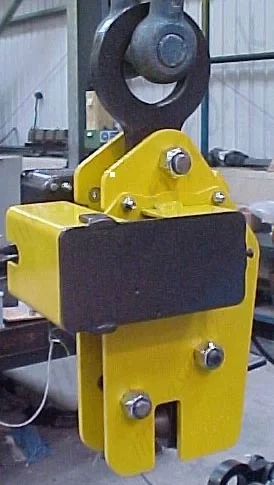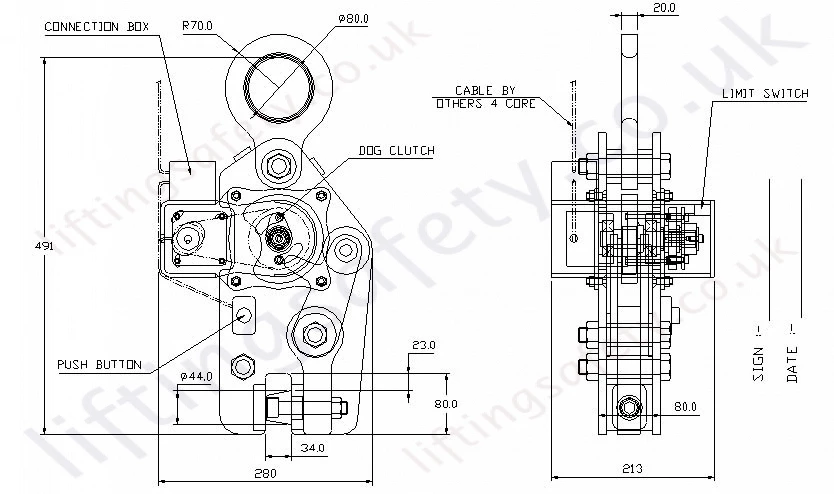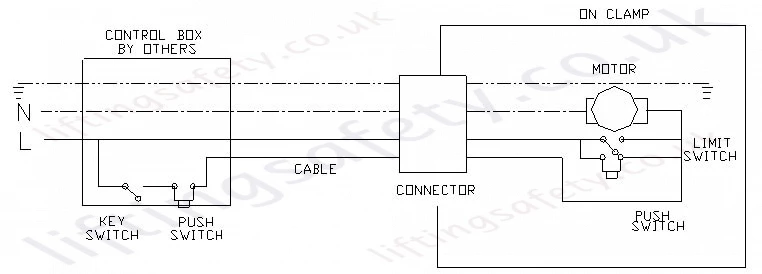
- Lifting Equipment
-
Height Safety

Height Safety Equipment
- Material Handling & Jacking Equipment
- Shop by Brand
- Clearance
-
Contact
Get In Touchsales@liftingsafety.co.uk +44 (0)1977 684 600
Motorised 24VDC Drop Test Clamp
Crane slung drop test clamp.
MDTC-4151



Not currently available. Please see our other remote release clamps for a possible alternative.
Drop test clamp (motorised)
Method of operation
- The clamp is hung from a crane hook by the Ø80mm hook ring.
- The clamp is connected to a control box with a 24VDC supply via a 5-core cable (earth, positive, switched feed, drop signal and negative return see sketch)
- The object to be dropped is connected to the clamp by a ring, typically a chain master link.
The clamp works by an electric motor turning a camshaft. The main drop cam has a hollow segment so that when it aligns with the release arm the jaws of the clamp can open. A high torque brush less stepper motor is used to drive the clamp, the control inverter is used to lock the motor in position The motor drives the cam via a toothed belt and overrun dog clutch. The dog clutch protects the motor and drive from the release torque by allowing the camshaft to accelerate ahead of the drive. A limit switch controls the motor so that the drive rotates the camshaft through 180º in successive steps.
Loading the clamp
- The clamp should be in the open position from the previous drop.
- If it is not. Then press the push button on the clamp for 5 seconds, the clamp will open.
- Place the ring into the mouth of the clamp.
- Press the push button on the clamp and hold for 5 seconds.
- The clamp will close and move to the lifting position.
- Isolate the power.
Releasing the load
- Lift the load to the required height.
- Energise the system.
- Press the release button on the control for 5 seconds.
- The clamp will move to the release position and the load will be dropped.
Dimensional Diagrams


Pricing
Unfortunately, this product has been discontinued and/or is no longer available. Please contact us for details on possible alternative products.
Contact Us About This Product
Not currently available. Please see our other remote release clamps for a possible alternative.
Drop test clamp (motorised)
Method of operation
- The clamp is hung from a crane hook by the Ø80mm hook ring.
- The clamp is connected to a control box with a 24VDC supply via a 5-core cable (earth, positive, switched feed, drop signal and negative return see sketch)
- The object to be dropped is connected to the clamp by a ring, typically a chain master link.
The clamp works by an electric motor turning a camshaft. The main drop cam has a hollow segment so that when it aligns with the release arm the jaws of the clamp can open. A high torque brush less stepper motor is used to drive the clamp, the control inverter is used to lock the motor in position The motor drives the cam via a toothed belt and overrun dog clutch. The dog clutch protects the motor and drive from the release torque by allowing the camshaft to accelerate ahead of the drive. A limit switch controls the motor so that the drive rotates the camshaft through 180º in successive steps.
Loading the clamp
- The clamp should be in the open position from the previous drop.
- If it is not. Then press the push button on the clamp for 5 seconds, the clamp will open.
- Place the ring into the mouth of the clamp.
- Press the push button on the clamp and hold for 5 seconds.
- The clamp will close and move to the lifting position.
- Isolate the power.
Releasing the load
- Lift the load to the required height.
- Energise the system.
- Press the release button on the control for 5 seconds.
- The clamp will move to the release position and the load will be dropped.
Dimensional Diagrams


Contact Us About This Product
If you wish to receive a quote for this product, please use the tab above, this form is for general enquiries regarding this product only.
You can also Request a Quote using the Quote tab above!
You can easily add more than one item to the Quote Request. This is highly recommended as we will be able to suit your needs much more efficiently.
Share this page!

